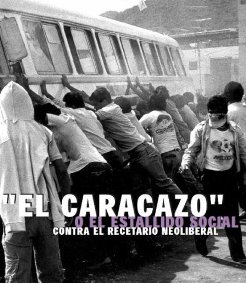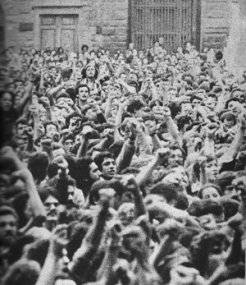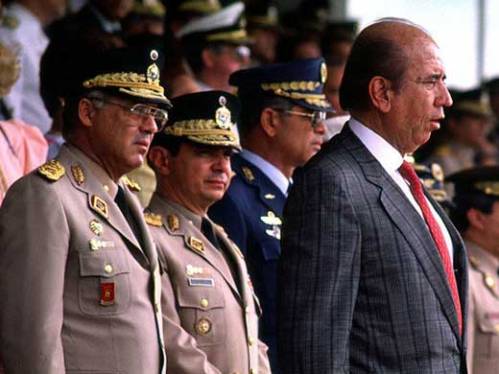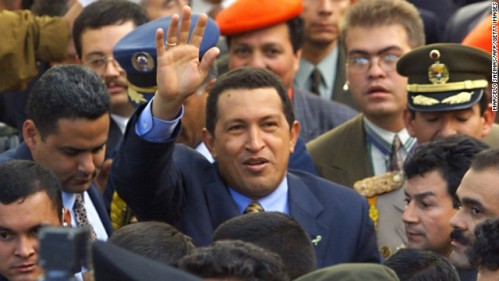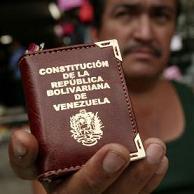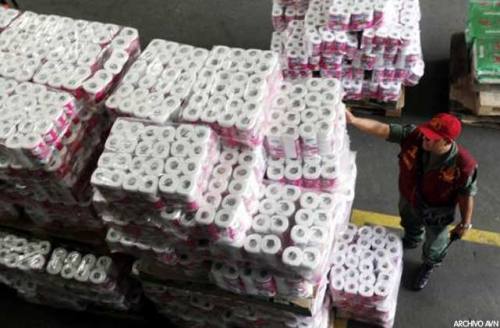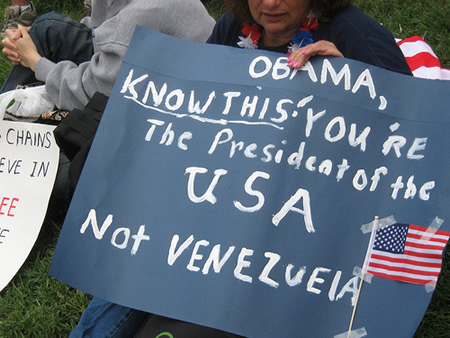|
Introduction
US relations with Venezuela illustrate the specific mechanisms with which an imperial power seeks to sustain client states and overthrow independent nationalist governments. By examining US strategic goals and its tactical measures, we can set forth several propositions about (1) the nature and instruments of imperial politics, (2) the shifting context and contingencies influencing the successes and failures of specific policies, and (3) the importance of regional and global political alignments and priorities.[1] Method of Analysis
A comparative historical approach highlights the different policies, contexts and outcomes of imperial policies during two distinct Presidential periods: the ascendancy of neo-liberal client regimes (Perez and Caldera) of the late 1980’s to 1998; and the rise and consolidation of a nationalist populist government under President Chavez (1999-2012).[2]
During the 1980’s and 1990’s, US successes in securing policies favorable to US economic and foreign policy interests under client rulers fixed, in the mind of Washington, the optimal and only acceptable model and criteria for responding (negatively) to the subsequent Chavez nationalist government.[3]
US policy toward Venezuela in the 1990’s and its successes were part and parcel of a general embrace of neo-liberal electoral regimes in Latin America. Washington and its allies in the International Monetary Fund (IMF), the World Bank (WB) and the Inter-American Development Bank (IDB) promoted and supported regimes throughout Latin America, which privatized and de-nationalized over five thousand public enterprises in the most lucrative economic sectors.[4] These quasi-public monopolies included natural resources, energy, finance, trade, transport and telecommunications. Neo-liberal client regimes reversed 50 years of economic and social policy, concentrated wealth, deregulated the economy, and laid the basis for a profound crisis, which ultimately discredited neo-liberalism. This led to continent-wide popular uprisings resulting in regime changes and the ruse if nationalist populist governments.
The historical-comparative approach allows us to analyze Washington’s response to the rise and demise of its neo-liberal clients and the subsequent ascendency of populist-nationalism and how regional patterns and changes influence the capacity of an imperial power to intervene and attempt to re-establish its dominance. Conceptual Framework
The key to understanding the mode and means of imposing and sustaining imperial dominance is to recognize that Washington combines multiple forms of struggle, depending on resources, available collaborators and opportunities and contingencies.[5]
In approaching client regimes, Washington combines military and economic aid to repress opposition and buttress economic allies by cushioning crises. Imperial propaganda, via the mass media, provides political legitimacy and diplomatic backing, especially when client regimes engage in gross human rights violations and high level corruption.
Conversely when attempting to weaken or overthrow a nationalist-populist regime, the empire will resort to multiple forms of attack including:[6]
Secretary of State John Kerry, while pursuing an apparent effort to re-open diplomatic relations via negotiations, simultaneously backed inflammatory declarations by Samantha Power, United Nations representative, which promised aggressive US intrusion in Venezuela’s domestic politics.
US-Venezuelan relations provide us with a case study that illustrates how efforts to restore hegemonic politics can become an obstacle to the development of normal relations, with an independent country. In particular, the ascendancy of Washington during the ‘Golden Age of Neo-liberalism’ in the 1990’s, established a fixed ‘mind set’ incapable of adapting to the changed circumstances of the 2000’s, a period when the demise and discredit of ‘free market’ client politics called for a change in US tactics. The rigidity, derived from past success, led Washington to pursue ‘restoration politics’ under very unfavorable circumstances, involving military, clandestine and other illicit tactics with little chance of success – given the new situation.
Comparative historical analysis of the strategic changes in international and regional politics, economies, markets and alignments provides a useful framework for interpreting US-Venezuelan relations, especially the successes of the 1990’s and the failures of the 2000’s. US-Venezuela Patron-Client Relations 1960’s -1998
During the decade from the late 1980’s to 1998, Venezuela signed[10] off on draconic International Monetary Fund programs, including privatizations of natural resources, devaluations and austerity programs, which enriched the MNCs, emptied the Treasury and impoverished the majority of wage and salary earners.[11] In foreign policy, Venezuela aligned with the US, ignored new trade opportunities in Latin America and Asia and moved to re-privatize its oil, bauxite and other primary resource sectors. President Perez was indicted in a massive corruption scandal. When implementation of the brutal US-IMF austerity program led to a mass popular uprising (the ‘Caracazo’) in February 1989, the government responded with the massacre of over a thousand protestors. The subsequent Caldera regime presided over the triple scourge of triple digit inflation, 50% poverty rates and double digit unemployment.[12]
The Caracazo 1989
Social and political conditions in Venezuela touched bottom at the peak of US hegemony in the region, the ‘Golden Age of Neo-Liberalism’ for Wall Street. The inverse relation was not casual: Venezuela, under President Caldera, endured austerity programs and adopted ‘open’ market and US-centered policies, which undermined any public policies designed to revive the economy. Moreover, world market conditions were unfavorable for Venezuela, as oil prices were low and China had not yet become a world market power and alternative trade partner. US and the Rise of Chavez: 1998-2001
The US viewed the Venezuelan elections of 1998 as a continuation of the previous decade, despite significant political signs of changes. The two parties, which dominated and alternated in power, the Christian democratic ‘COPEI’, and the social democratic ‘Democratic Action Party’, were soundly defeated by a new political formation headed by a former military officer, Hugo Chavez, who had led an armed uprising six years earlier and had mounted a massive grass-roots campaign, attracting radicals and revolutionaries, as well as opportunists and defectors from the two major parties.[13]
Washington’s successes over the previous decade, the entrenched ascendancy of neo-liberalism and the advance of a regional US ‘free trade agreement’ blinded the Clinton regime from seeing Washington tended to write-off Chavez’s promises of a new constitutional order and new ‘Bolivarian’ foreign and domestic policies, including nationalist-populist reforms, as typical Latin American campaign rhetoric. The general thinking at the US State Department was that Chavez was engaging in electoral demagogy and that he would ‘come to his senses’ after taking office.[14] Moreover Washington’s Latin Americanists believed that the mix of traditional politicians and technocrats in his motley coalition would undermine any consequential push for leftist radical changes.[15]
Early on, President Chavez recognized the institutional obstacles to his nationalist socio-economic reforms and immediately called for constitutional changes, convoking elections for a constituent assembly, which he won handily. Washington’s growing concerns over the possible consequences of new elections were tempered by two factors: (1) the mixed composition of the elected assembly (old line politicians, moderate leftists, radicals and ‘unknowns’) and (2) the appointment of ‘moderates’ to the Central Bank as well as the orthodox economic policies pursued by the finance and economic ministries. Prudent budgets, fiscal deficits and balance of payments were at the top of their agendas.
Strategically, Chavez succeeded in creating a strong political institutional base in the legislature, civil administration and military, which could (or would) approve and implement his national-populist agenda. Unlike Chilean Socialist President Salvador Allende, Hugo Chavez first consolidated his political and military base of support and then proceeded to introduce socio-economic changes.
By the end of 2000, Washington moved to regroup its internal client political forces into a formidable political opposition. Chavez was too independent, not easily controlled, and most important moving in the ‘wrong direction’ - away from a blind embrace of neo-liberalism and US-centered regional integration. In other words, while Chavez was still well within the parameters of US hegemony, the direction he was taking portended a possible break. The Turning Point: Chavez Defies the ‘War on Terror’ 2000-2001
The first decade of the new millennium was a tumultuous period which played a major role in defining US-Venezuelan relations. Several inter-related events polarized the hemisphere, weakened Washington’s influence, undermined collaborator-client regimes and led to a major confrontation with Venezuela.
In this vortex of change, President Chavez rejected Washington’s ‘War on Terror’, rejecting the logic of ‘fighting terror with terror’. By the end of 2001, Washington dispatched a top State Department official and regional ‘enforcer’ to Caracas where he bluntly threatened dire reprisals – destabilization plans – if Caracas failed to line up with Washington’s campaign to reimpose global hegemony.[19] Chavez dismissed the official’s threats and re-aligned his nation with the emerging Latin American nationalist-populist consensus. In other words, Washington’s aggressive militarist posture backfired: polarizing relations, increasing tensions and, to a degree, radicalizing Venezuela’s foreign policy.
Washington’s intervention machine (the ‘coup-makers’) went into high gear: Ambassador Charles Shapiro held several meetings with the FEDECAMARAS (the Venezuelan business association) and the trade union bosses of the CTV (Venezuelan Trade Union Confederation).[20] The Pentagon and the US Southern Command met with their clients in the Venezuelan military. The State Department increased contacts and funding for opposition NGO’s and rightwing street gangs. The date of the coup had been set for April 11, 2002. With the buildup of pressure, preparatory for the threatened coup, the Chavez government began to assess its own resources, contacting loyal military units, especially among the armored battalions and paratroopers.
In this heated and dangerous atmosphere, local neighborhood committees sprang up and mobilized the poor around a more radical social agenda defending their government while the US-backed opposition unleashed violent street clashes.[21] The coup was warmly welcomed by Washington and its semi-official mouthpiece, the New York Times,[22] as
Washington had played a risky card in its haste and lost on several fronts: First of all, US support for the coup strengthened the anti-imperialist sectors of Chavez’s Bolivarian movement. Chavez discarded any residual illusions of ‘reaching an accommodation’ with Washington. Secondly, the loss of key military assets weakened Washington’s hope for a future military coup. Thirdly, the complicity of the business groups weakened their ability to influence Chavez’s economic policies and nudged him toward a more statist economic strategy. Fourthly, the mass mobilization of the poor to restore democracy moved the government to increase spending on social welfare programs. Anti-imperialism, the demand for social welfare and the threat to Venezuelan national security led Chavez to establish strategic ties with Cuba, as a natural ally.
Washington implemented its ‘global militarization’ of US foreign policy. Under the subterfuge ‘War on Terror’ – a formula for global intervention, which included the invasion of Afghanistan in 2001 and, the war against Iraq in 2003, imperial policymakers have plunged ahead with new aggressive policies against Venezuela.
In other words, US empire builders used (and sacrificed) their economic assets in their attempt to restore hegemony via military means. The military and strategic dimensions of the US Empire took precedence over ‘Big Oil’. This formed a template clearly evident in all of its subsequent imperial actions against Iraq, Libya and Syria and its severe economic sanctions against Iran. The same hegemonic priorities played out in Washington’s intervention in Venezuela – but failed.
Contrary to some theorists of imperialism, who have argued that imperialism expands via economic ‘dispossession’ [24], recent history of US-Venezuela relations demonstrate that 21st US imperialism grows via political intervention, military coups and by converting economic collaborators into political agents willing to sacrifice US corporate wealth to secure imperial military-political domination.
Within 48 hours of the coup, Chavez was restored to power – striking the first blow to Washington’s ambitions for ‘regime change’ in Venezuela. The second blow came with the defeat of the US-backed oil bosses’ lockout. Washington had counted on its close ties with the senior executives of the state oil company (PDVS) and the heads of the oil workers union.[25] Washington did not realize that about half of the oil workers and a number of company and union bosses would staunchly opposed the lockout while other Latin American oil producers would supply Venezuela and break the ‘bosses’ strike.
These twin defeats, the military-business coup and the bosses’ lockout, had a profound impact on US-Venezuelan relations. The US lost its strategic internal assets – business and trade union elites who then fled to ‘exile’ in Miami or resigned. Pro-US oil executives were replaced by nationalists. Washington’s direct imperial intervention pushed the Chavez government in a new, radical direction as it moved decisively from conciliation to confrontation and opposition. The government of Venezuela launched a radical, nationalist, populist agenda and actively promoted Latin American integration. Venezuela inaugurated UNASUR, ALBA and PetroCaribe, undermining the US-centered free trade treaty (ALCA).
Washington’s military-interventionist strategy was undermined by the loss of their key collaborators. The White House switched to its clients in the opposition parties and, especially, to so-called non-governmental organizations (NGOs) channeling funds via the ‘National Endowment for Democracy’ and other “front groups”. They bankrolled a ‘recall referendum’, which was decisively defeated, further demoralizing the rightwing electorate and weakening remaining US clients.[26]
Having lost on the military, economic and electoral fronts, Washington backed a boycott of Congressional elections by the opposition parties- leading to the final debacle in its program to de-legitimize and destabilize the Chavez government. Pro-Chavez candidates and parties swept the election gaining an overwhelming majority. They went on to approve all of the government’s nationalist-social reform agenda. The US-backed opposition lost all institutional leverage.
The US imperial failures from 2002-2005 did not merely ‘reflect’ mistaken policies; these signaled a more profound problem for the empire - its inability to make an accurate estimate of the correlation of forces. This strategic failure led it to continue throwing its marginalized domestic assets into conflict with less resources and support. Despite repeated defeats, Washington couldn’t grasp that popular power and nationalist allegiances within the military had successfully countered the US business-military intervention. Political hubris underpinning a military-driven imperialist ideology had blinded
Imperial Policy During the Commodity Boom 2004-2008
With virtually no collaborators of consequence, Washington turned toward the ‘outside’ destabilization strategy using its only loyal regional client, the death squad narco-President Alvaro Uribe of Colombia. Bogota granted Washington the use of seven military bases, numerous airfields and the establishment of Special Forces missions- preparatory for cross border intrusions. The strategy would be to launch a joint intervention under the pretext that Venezuela supplied and sheltered the FARC guerillas.
World events intervened to thwart Washington’s plans: the invasion of Iraq and the bloody occupation of Afghanistan, looming conflicts with Iran and low intensity warfare in Somalia, Yemen and Pakistan, had weakened the empire’s capacity to intervene militarily in Venezuela. Every country in the region would have opposed any direct US intervention and Colombia was not willing to go it alone, especially with its own full-scale guerrilla war against the FARC.
Venezuela’s trade surplus and high export revenues rendered the traditional Washington financial levers like the IMF and World Bank impotent.[28] Likewise, Venezuela had signed multi-billion dollar arms trade agreements with Russia, undermining any US boycott. Trade agreements with Brazil and Argentina reduced Venezuela’s need for US food imports.
All the oil multinationals continued normal operations in Venezuela, except US companies. The government’s selective nationalization program and gradual increases in taxes and royalty payments undercut EU support for the US, given the high world price of oil (exceeding $100 dollars a barrel). Chavez’s left-turn was well-funded. The oil revenues funded a wide-range of social programs, including subsidized food, housing and social welfare, healthcare and educational programs led to a sharp drop in poverty and unemployment. This secured a strong electoral base for Chavez. The ‘pivot to the Middle East’, following Bush’s declaration of the ‘Global War on Terror, bogged the US down in a series of prolonged wars, undermining its quest to regain regional power.[29]
Washington did not lack partners: New bilateral trade agreements were signed with Chile, Panama, Colombia and Mexico. The Pentagon engineered a bloody coup in Honduras against a democratically elected President. The National Security Agency engaged in major cyber-spying operations in Brazil, Argentina, Mexico and the rest of the continent.[31] The White House poured over six -billion dollars into Colombia’s armed forces to serve as a proxy for the US military. These “gains” had little impact. US support for the coup-makers in Honduras may have overthrown an ally for Chavez in ALBA but it led to even greater diplomatic isolation and discredit for Washington throughout Latin America. Even Colombia denounced the US coup against the Honduran president. While US military support for Colombia contributed to some border tensions with Venezuela, the election of President Santos in Bogota brought significant movement toward peaceful reconciliation with Venezuela. Whereas trade between Colombia and Venezuela had fallen to less than $2 billion dollar a year, with Santos’ conciliatory policy it rose sharply to nearly $10 billion.[32]
Washington’s external strategy was in shambles. The program of NSA cyber-spying against regional leaders, revealed by Edward Snowden, resulted in outrage and greater animosity toward Washington. The President of Brazil was especially incensed and
Washington viewed President Chavez and, his successor President Maduro’s regional strategy as a security threat to US hegemony rather than an economic challenge. Venezuela’s success in forging bilateral ties, even with US clients like Colombia and Mexico, and a number of English-speaking Caribbean islands, undermined efforts to ‘encircle and isolate’ Venezuela. Caracas success in financing and backing multi-lateral regional economic and political organizations in South America and the Caribbean, which excluded the US, reflects the power of oil diplomacy over saber rattling. Venezuela’s PetroCaribe program won the support of number of neo-liberal and center-left regimes in the Caribbean, which had previously been under US hegemony. In exchange for subsidized oil prices, medical aid and interest-free loans, these US clients started rejecting Washington’s intervention. ALBA brought together several center-left governments, including Bolivia, Ecuador and Nicaragua, into a common political bloc opposing US meddling.
ALBA rejected regime change via coups throughout Latin America and opposed Washington’s wars in Iraq, Libya, Syria and elsewhere. Venezuela successfully joined the powerful economic bloc, MERCOSUR, enhancing its trade with Brazil, Argentina and Uruguay. Venezuela’s strategic alliance with Cuba (trading its oil for Cuba’s medical services) made the massive Bolivarian health program for the poor a great success, cementing Chavez and Maduros’ electoral base among the Venezuelan masses. This undermined Washington’s well-funded program of ‘NGO’ subversion in poor neighborhoods. Venezuela successfully undercut Bush and Obama’s efforts to use Colombia as a ‘military proxy’ when it signed a historic peace and reconciliation agreement with President Santos. Colombia agreed to end its cross-border paramilitary and military incursions and withdrew its support for US destabilization operations in exchange for Venezuela closing guerrilla sanctuaries, re-opening trade relations and encouraging the FARC to enter into peace negotiations with the Santos regime.[33] Santos’ embrace of Venezuela’s trade and diplomatic ties eroded Washington’s policy of using Colombia as a trampoline for military intervention and forced imperial policy-makers to turn to its domestic Venezuelan clients through elections as well as internal ‘direct action’, e.g. the sabotage of power stations and the hoarding of essential food and commodities.
Imperialism’s Multi-Track Opposition
US hostility toward Venezuela occurs at three levels of conflict: At the country-level, Venezuela marks out a new development paradigm which features public ownership over the free market, social welfare over multi-national oil profits and popular power over elite rule. At the regional level Venezuela promotes Latin American integration over US-centered Latin American Free Trade Agreements, anti-imperialism over “pan-Americanism”, foreign aid based on reciprocal economic interests and non-intervention as opposed to US military pacts, narco-military collusion and military bases.[35]
At the global-level Venezuela has rejected the US invasions of Afghanistan and Iraq, ignored US trade sanctions against Iran, opposed Washington and NATO’s bombing of Libya and the proxy invasion of Syria. Venezuela condemns Israel’s colonization and annexation of Palestine. In other words, Venezuela upholds national self-determination against US military driven imperialism.[36]
Presidents Chavez and Maduro have presented a successful alternative to neo-liberalism. Venezuela demonstrates that a highly globalized, trade dependent economy can have an advanced welfare program. The US, on the other hand, as it ‘globalizes’, has been eliminating its domestic social welfare programs in order to finance imperial wars. Venezuela has shown the US public that a market economy and large social welfare investments are not incompatible. This paradigm flies in the face of the White House’s message. Moreover, US Empire builders have no economic initiatives compete with Venezuela’s regional and global alliances. This situation is very different from the 1960’s when President Kennedy proposed the ‘Alliance for Progress’, involving trade, aid and reforms, to counter the revolutionary appeal of the Cuban revolution.[37] Presidents Bush and Obama could only ‘offer’ costly military and police co-operation and worn-out neo-liberal clichés accompanied by market constraints.
Despite its severe diplomatic setbacks, regional isolation, the loss of its military platform, and an economic boom, driven by the high world price of oil, Washington keeps on trying to destabilize Venezuela. Beginning in 2007, imperial strategy re-focused on elections and domestic destabilization programs. Washington’s first success occurred when it backed a campaign against new constitutional amendments in December 2007 defeating Chavez by 1%. This happened right after his substantial Presidential re-election victory. The overtly socialist constitution proved too radical for a sector of the Venezuelan electorate.[38]
Since 2008 Washington has infused large sums of money into a variety of political assets, including NGOs and middle class university students’ organization engaged in agitation and anti-Chavez street demonstrations.[39] The goal was to exploit local grievances. US funding of domestic proxies led to extra-parliamentary, destabilization activity, like sabotage, disrupting Venezuela’s economy while blaming the government for ‘public insecurity’ and covering up opposition violence.
The business community started hoarding essential goods in order to provoke shortages and whip up popular discontent. The opposition media blamed the shortages on state ‘inefficiency’. Opposition political parties started receiving significant US funding, on condition that they unified and ran on a single slate in contesting elections and questioned the legitimacy of the election results (claiming ‘fraud’) after their defeat.
In summary, US efforts to restore its hegemony in Caracas involved a wide range of domestic clients from violent paramilitary groups, NGO’s, political parties, elected officials and manufacturing and commercial executives linked to the production and distribution of essential consumer goods.
The shifts in Washington’s policies, from internal violence (coup of 2002, oil lockout of 2002-03), and cross border military threats from Colombia (2004-2006), returning to internal domestic elections and campaigns of economic sabotage reflects recent attempts to overcome failed policies without surrendering the strategic objective of restoring hegemony via overthrowing the elected government (“regime change” in the imperial lexicon). Seven Keys to Imperial Politics: An Overview
Washington’s effort to restore hegemony and reimpose a client regime in Caracas has last over a decade and involves the empire’s capacity to achieve seven strategic goals: Imperialism is not simply a ‘policy’ it is a structure. It has a powerful military aid component dependent on strategically placed collaborators and supporters in targeted countries and operating in a favorable (crisis-ridden) environment. Imperialism flourishes when its military and diplomatic approach serves economic interest benefiting both the ‘home market’ and local collaborators. In the second decade of the 21st century, the dominance of ‘military-driven imperialism’ bled the domestic economy, destroying and impoverishing the targeted society and shattering living standards. The recent devastating wars in the Middle East have dismantled entire societies and weakened US-client elites. Latin American and Venezuelan development-oriented leaders took a long look at the destruction wrought by US policy elsewhere and turned to new partners - the newly emerging economic powers with growing markets. These new partners, like China, pursue economic ties, which are not accompanied by military and security threats of intervention. Chinese investments do not include military missions and massive spy networks, like the CIA, DEA, and NSA, posing threats to national sovereignty. The Imperial Dynamic and the Radicalization of Venezuelan Politics Imperial intervention can have multiple and contrasting effects: It can intimidate a nationalist government and force it to renege on its electoral promises and revert to a liberal agenda. It can lead to an accommodation to imperial foreign policies and force a progressive government to moderate domestic reforms. It can lead to concessions to
The range of systemic responses illustrates the analytical weakness of the so-called ‘center-periphery’ framework, which lumps together: a) disparate political, social and economic internal configurations, b) opposing strategies and responses to imperialism and c) complex international relations between imperial and nationalist regimes. The polar opposite responses and political-economic configurations of the US and China (so-called ‘centers’) to Venezuela further illustrates the lack of analytical utility of the so-called ‘world system’ approach in comparison with a class-anchored framework. The imperial dynamic, the drive by Washington to reassert hegemony in Venezuela by violent regime change, had the unintended consequence of radicalizing Chavez’ policies, consolidating power and furthering the spread of anti-imperialist programs throughout the region.[41] In the first years of the Chavez government, 1999-2001, Venezuela pursued largely orthodox policies and sought friendly relations with Washington, while espousing a Bolivarian vision. In this period, Chavez did not implement his vision. He did not try to set up any regional organizations that excluded the US. Nevertheless, Washington retained its ties to the opposition and sought to influence a motley collection of opportunist politicos who had jumped on the Chavez bandwagon while countering the leftists in the coalition government.
Washington immediately started to implement plans to overthrow the Chavez government leading to the bloody, but unsuccessful coup of April 2002. If the trigger for US imperial intervention was Chavez lawful opposition to Washington’s global military strategy, the defeat of the coup and his restoration to power, led a re-definition of Venezuelan-US relations. Bilateral relations went from co-existence to confrontation. Venezuela began looking for regional allies, actively supporting left and nationalist movements and
The threat from the US pushed Chavez to re-define the nature of the political process from ‘reform’ to ‘revolution’; from moderate nationalism to 21st century socialism; from a bilateral conflict to a regional confrontation. Venezuela sponsored and promoted several key alliances including ALBA and PetroCaribe; Chavez later broadened Venezuela’s regional ties to include UNASUR and MERCOSUR. Venezuela’s radical rejection of US hegemony was, however, tempered by structural limitations which provided US empire builders and internal clients with access points to power. The ‘socialization’ program did not affect 80% of the economy. Banking, foreign trade, manufacturing and agriculture remained under private ownership. Over 95% of the public watched programs from a domestic mass media owned by US-backed private clients.[43] Transport, food distributors and supermarkets remained privately owned. Campaigns and elections remained vulnerable to foreign funding by the National Endowment for Democracy and other US conduits. While the mixed economy and open electoral system, secured approval from Latin America’s center-left regimes and neutralized some of the hostile US propaganda, they also allowed the empire to use its local collaborators to commit sabotage, hoard vital consumer goods and create shortages, stage violent street confrontations during elections and permitted the mass media openly call for insurrection. The dialectic confrontation between US imperial aggression and Venezuelan nationalism deepened the revolution and spread its appeal overseas. Venezuela’s successful defiance of US imperialism became the defining reality in Latin America. Imperialism, based on militarism and regime destabilization, led Venezuela to begin a process of transition to a post neo-liberal, post-capitalist economy rooted in regional organizations. Yet this process continued to reflect economic realities from the capitalist past. The US remained Venezuela’s most important petroleum market. The US, caught up in Middle-East wars and sanctions against oil producers (Iraq, Iran, Libya and Syria) was not willing to jeopardize its Venezuelan oil imports via a boycott. Necessity imposed constraints on even imperial aggression as well as Venezuela’s ‘anti-imperialism’. Conclusion
US imperialist relations in Latin America have changed dramatically in line with the internal changes in class relations. US financial and militarist elites, not industrial-manufacturers, now dictate policy. The relocation of US manufacturers to Asia and elsewhere has been accompanied by the ascendancy of a power configuration whose political pivot is in the Middle East and, in particular, in their own words, ‘securing Israel’s superiority in the region’. This has had two opposing effects: On the one hand it has led imperial policymakers to pursue non-economic militarist agendas in Latin America and, on the other, to ‘neglect’ or allocate few resources, investments and attention to cultivating clients in Latin America. Inadvertently, the ‘Middle East pivot’ and the militarist definition of reality has allowed Latin America to secure a far greater degree of independence and greater scope for cultivating diverse economic partners in the 21st century than was possible for the greater part of the 20th century. Have US-Latin American relations permanently changed? Has Venezuela consolidated its independence and achieved the definitive defeat of imperial intervention? It would be premature to draw firm conclusions despite the substantial victories achieved during the first decade and a half of the 21st century.
Obama’s affirmation of the US ‘right to spy’ prompted new anti-imperialist measures, including proposals to end ties to US-based and controlled information networks. In other words, new imperial methods of colonization based on new technologies triggers new anti-imperial responses, at least for independent states.
The anti-neoliberal governments in Latin America, heading up the struggle against US hegemony, face serious challenges resulting from the continuing presence of private banking and finance groups, US based multi-nationals and their local collaborators in the political parties. Except for Venezuela and Bolivia, on-going US-Latin American joint military programs provide opportunities for imperial penetration and recruitment. The high dependence of Venezuela and the other center-left countries (Ecuador, Argentina, Brazil, Bolivia, etc.) on commodity exports (agriculture, minerals and energy) exposes the vulnerability of their finances and development and social welfare programs to fluctuations and sharp downturns in global export revenues.[44]
Intra-Latin American trade (greater regional integration) is growing and internal markets are expanding. But without changes in class relations, domestic and regional consumer demand cannot become the motor force for a definitive break with imperialist-dominated markets. In the face of a second world economic crisis, the US may be forced to reduce its global military operations, but will it return to hemispheric dominance? If commodity demand drops and the Chinese economy slows, do post-neoliberal regimes have alternative economic strategies to sustain their independence? Imperial power in Latin America and in Venezuela in particular, has suffered serious setbacks but the private property power structures are intact and imperial strategies remain. If the past half-century offers any lessons, it is that imperialism can adapt different political strategies but it never surrenders its drive for political, military and economic domination.
Political Chronology of Venezuela December 1998: Chavez elected 1999: Three referendums all successful: to establish constituent assembly to draft new constitution; to elect membership of constituent assembly; to approve new constitution. July 2000: ‘Mega-election’: to elect President, national legislators and state and municipal officials. Chavez wins 6 year term with approx. 60% of the popular vote, his Patriotic Pole coalition wins 14 of 23 governorships and majority of seats in National Assembly April 2002: Failed US backed military-civilian coup December2, 2002 – Feb. 4, 2003: Failed oil executive and businessmen lockout to topple Chavez government. August 2004: Recall referendum which Chavez wins by substantial margin December 2005: Legislative elections: opposition boycotts, results in Chavez supporters dominating the National Assembly. December 2006: Chavez re-elected with approx. 63% of the popular vote December 2007: Chavez constitutional amendment package (‘21st Century Socialism’) narrowly defeated in national referendum 2008: Chavez moves to unite supporters into a single party – the United Socialist Party of Venezuela (PSUV) November 2008: State and municipal elections: pro-Chavez candidates won 17 of 22 governors’ races and 80% of more than 300 mayoral races January 2009: National Assembly votes to hold referendum on constitutional amendment to abolish terms limits for all elected government officials. February 2009: Referendum approved 55% to 45%. September 2010: National Assembly elections, Chavez supporters won 98 seats (94 for PSUV candidates) versus 87 seats for opposition parties (65 won by 10 opposition parties known as Democratic United Platform/MUD). But the Government failed to win enough seats to enact various part of government agenda such as approving constitutional reforms. October 2012 Presidential elections: Chavez wins with approx. 55% of popular vote. December 2012: State and municipal elections, PSUV sweeps to victory. April 2013: Chavez successor Nicholas Maduro wins election by 51% to 49%.
NOTES [1] James Petras and Henry Veltmeyer, Imperialism and Capitalism in the 21st Century (Ashgate: London 2013) [2] Steve Ellner Rethinking Venezuelan Politics: Class, Conflict and the Chavez Phenomenon (Lynn Reiner: Boulder, Colorado (2009)
[3]James Petras, “US-Latin American Relations: Ruptures, Reaction and Illusions of Times Past”, JPetras LaHaine, 11/2/06
[4] World Development Reports (World Book: 1991-2001) Washington D.C., IMF Staff Country Report No 98/117, October 1998, Washington, DC
[5] James Petras, “Rethinking Imperialist Theory”, JPetrasLaHaine, 12/21/2010
[6] James Petras, “US-Venezuelan Relations: Imperialism and Revolution”, JPetrasLaHaine, 1/5/2010. Eva Golinger, The Chavez Code: Cracking US Intervention in Venezuela (Olive Branch Press 2006).
[7] James Petras, “Venezuelan Elections: A Choice and Not an Echo”, JPetrasLaHaine, 10/4/12 and “Beyond President Chavez Electoral Victory: Socialism in a Rentier State”, JPetrasLaHaine, 10/26/2013.
[8] James Petras, “Networks of Empire and Realignments of World Power”, JPetrasLaHaine, 1/2/2011; Financial Times 4/26/2011, Special Supplement “Latin America: New Trade Routes”
[9]Richard Gott, Hugo Chavez: The Bolivarian Revolution in Venezuela (Verso: London 2005). Gregory Wilpert, Changing Venezuela by Taking Power: The History and Policies of the Chavez Government (Verso: London 2007).
[10] James Petras et al, The Nationalization of Venezuelan Oil (Praeger: New York 1977).
[11] IMF Staff Country Reports, No. 98/17, October 1998.
[12] World Bank Country Report: 2000. (Washington DC 2001)
[13] Ellner opcit and Wilpert opcit
[14] Interviews State Department, November 2009 [15] ibid [16] Interviews State Department, January 2001 [17] ibid [18] James Petras and Henry Veltmeyer, Social Movements in Latin America; Neo-Liberalism and Popular Resistance (New York: Palgrave/MacMillan 2013).
[19] Interview with President Chavez, January20, 2002
[20] Eva Golinger, Bush versus Chavez (New York: Monthly Review Press 2007)
[21] George Ciccariello Maher, We Created Chavez: A Peoples History of the Venezuelan Revolution (Durham: Duke University Press 2013).
[22] New York Times, April 12, 2002, page 1 [23] El Mundo (Madrid) April 12, 2002, page 1 [24] David Harvey, The New Imperialism (London Oxford Press 2005)
[25] Ellner opcit; Wilpert opcit
[26] Eva Golinger, The Chavez Code, ibid
[27] Ellner opcit
[28] In 2008 5 the Chavez government broke ties with the IMF and World Bank. Interview official Venezuelan Foreign Office, November 2008
[29] Mark Weisbrot and Luis Sandoval: The Venezuelan Economy in the Chavez Years. (Center for Economics and Policy) Washington D.C. 2008; National Institute of Statistics cites the reduction of extreme poverty of over 50%, a decline from 5.4 million Venezuelans in 1998 to 2.4 million in 2011.
[30] James Petras, “Networks of Empire and Realignments of World Power”, JPetrasLaHaine, 1/2/11. Financial Times “China is now Regions Biggest Partner”, Special Report, 4/26/2011 and page 4.
[31] La Jornada, September 30, 2013.
[32] James Petras, “Chavez Right-turn: State Realism versus International Solidarity”, JPetrasLaHaine, 6/13/2011
[33] James Petras, “President Chavez and the FARC: State and Revolution”, JPetrasLaHaine, 7/3/2008
[34] La Jornada, September 30, 2013.
[35] Interview President Chavez Caracas, November 7, 2006 [36] Ibid [37] James Petras and Maurice Zeitlin, Latin America: Reform or Revolution, (New York Fawcett 1968)
[38] Gregory Wilpert, “An Assessment of Venezuela’s Bolivarian Revolution at Twelve Years”, Venezuelanalysis.com, 2/2/2011
[39] Eva Golinger “Documents Reveal Multimillion-dollar Funding to Journalists and Media in Venezuela”, [40] Weisbrot and Sandoval, opcit [41] George Ciccariello-Maher, We Created Chavez, opcit. Steve Ellner, Rethinking Venezuelan Policies, opcit
[42] Interview Foreign Affairs official, Caracas, November 6, 2006
[43] “Private Opposition TV Continues to Dominate in Venezuela”, Center for Economy ad Policy Research: Washington D.C., 12/13/2010.
[44] “Beyond President Chavez Electoral Victory” Socialism in a Rentier State”, JPetrasLaHaine, 10/26/12; G. Wilpert, “An Assessment …”, opcit. |

